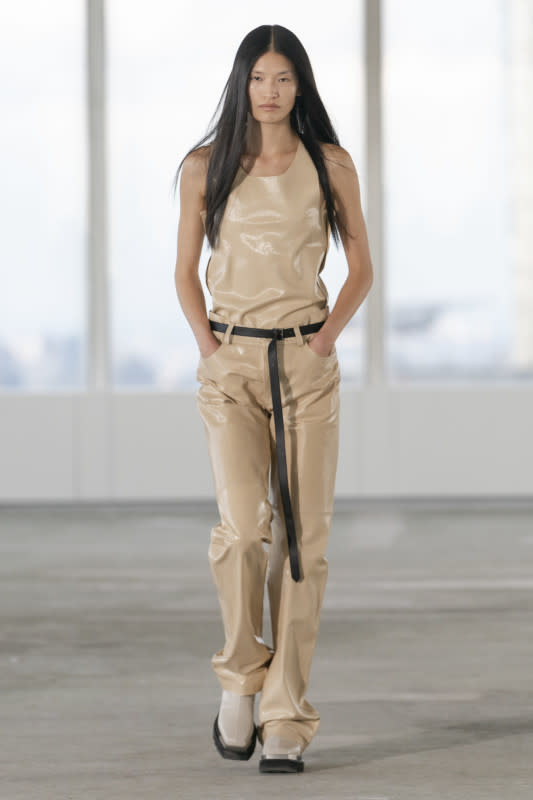The Most Exciting Advancements in Fabric Innovation Right Now
Was it obvious that the cream-colored, mirrored crochet dress on Stella McCartney's runway was made of seaweed? Or that Peter Do's latex-looking wide-leg pants were crafted from shrimp shells and mushrooms? Fashion's most exciting fabric innovations are visually discrete, but they underscore the advancements being made in 2024 using unlikely sources — namely, food waste and ocean matter.
The industry is well-aware of its daunting environmental impacts, from its carbon emissions to its water pollution. Material innovation has been a cornerstone of brands' sustainability strategies, a big one being opting for recycled nylons and polyesters versus the virgin, plastic-based fibers. According to Keel Labs CEO Tessa Callaghan, fashion relies predominantly on three main groups of raw materials for garments and textile-based applications: petroleum or petrochemical-reliant synthetics, cotton and tree pulp. "There are smaller sectors, like cashmeres and silks, but where the majority of textiles come from is monopolized [by these three]," she tells Fashionista.
For many years, material innovation in fashion has largely focused on upcycling textile waste and creating alternatives to genuine leather. (The latter requires a carbon-intensive process, and its overconsumption is tied to deforestation.) Now, the conversation has gotten more granular, more concerned with the actual fibers — specifically, "replacing synthetic fibers in yarns with natural or recyclable ones," says Alan Lugo, director of footwear strategy at Natural Fiber Welding (NFW). This requires a "dramatic diversification of our resources," per Callaghan: "In order to maintain and create prosperity for our futures, it means dispersing the reliance on the various organisms and raw materials."
Companies like Keel Labs and TomTex have stepped in to address that need. Keel Labs' algae-based Kelsun looks and feels like a natural fiber, and has already appeared in collections by Stella McCartney. TomTex uses shrimp shells and mushrooms to create its proprietary materials that mimic leather, suede, latex and more; it has already worked with Peter Do on its Spring 2023 faux leather and Dauphinette on its Fall 2024 handbags.
"I'm very sensitive to over-consumption and waste because I see the impact back home," TomTex Founder Uyen Tran, who was born and raised in Vietnam around textile manufacturers, says. She's haunted by the pollution that flushes back into Southeast Asia and Asian countries, so the company's mission is personal to her.

TomTex for Dauphinette Fall 2024

Photos: Launchmetrics Spotlight
An emphasis on fully bio-based materials
Cactus and apple leathers entered the market as buzzy alternatives to cowhide, making it possible to tote around a "leather" bucket bag or coat and feel good about it — but here's the catch: Leather alternatives like these still rely heavily on polyester and only use the natural product as filler. "[They're] incrementally better, but [are not] fundamentally solving the problem of getting plastics out of those materials," Lugo says.
The emphasis now is on making 100% bio-based materials. "We truly believe that green chemistry and using something that already exists as an input to produce material is the best way to move forward," Tran explains. "We use chitosan, the most abundant [biopolymer] on earth, and mix it with green substances to create our material. It's a hundred percent bio-based, so there's no plastic and no petrochemical ingredients. It's naturally biodegradable as well."
NFW is similarly focused on fully plant-based materials. Take the company's Mirum, for example, which is made of a mix of natural rubber, plant-based oil and minerals: It can be used in everything from fashion to furniture to cars, helping reduce the need to rely on plastics and leather at scale. "We try to leverage the abundance of nature's materials and leverage existing infrastructure as much as possible," Lugo adds.
Julia Marsh, the CEO of the packaging alternatives company Sway, makes the case for seaweed — which "is abundant and grows on every coastline in the world. It doesn't require intensive inputs like arable land or fresh water or pesticides or fertilizer. It's also rich in natural polymers." This allows it to mimic plastic's molecular structure and, thus, its characteristics. (Sway uses similar green chemistry to the alternative fabric makers to replace the polyester bags often used to package apparel.)

TomTex for Peter Do Spring 2023

Photos: Launchmetrics Spotlight
How to scale
Pricing is very important when it comes to these material alternatives.
"If you don't make something that's accessible and affordable, you won't make any impact — it's going to be just a few small collections, and that's not what the industry needs to move forward," Tran argues. "We want the technology to be a real solution moving forward." A principle for TomTex is that "all the inputs and ingredients need to have a very good price point, so that when you add up everything together, the price can be similar to the conventional material that we want to replace."
This is, after all, a longstanding issue: A big argument around "sustainable" goods is that they're often priced higher than the alternatives, and thus potentially out of reach for most consumers. Scientists keep this in mind when creating newness, but brands need to buy in, too. "[We] need brands to launch things, to want the material to signal demand and actually place orders," Lugo says. "To do that, [brands] have to understand how to market it and sell it."
These companies have had to rethink not just their materials, but also how they market them to potential brand partners. Lugo has noticed how larger companies tend to be attracted to carbon-reduction stories, while smaller ones focus on things like being plastic-free.
"My mantra is: This is science, not magic," Tran says. "Sometimes, we're dealing with something that has never been on the market before. It's a material that's not commercialized when we pioneer something. It's a good thing, because a lot of people now have awareness and demand these materials."
It helps that venture capital is financing these companies, and that there's growing industry support for them through awards like the Tom Ford Plastics Prize or Kering's Generation Award. This is part of why, today, it's possible to wear a dress made of rose petal cellulose, carry a handbag made of mushroom leather or sport plastic-free footwear. The needle is moving — but there's still plenty of room to grow.
What comes next
Callaghan hopes to see "a holistic integration of innovations: Are we blending our textiles or are we blending our yarns with next-generation materials? Are they being dyed with safe and sustainable dye systems? Are they incorporating finishes that allow the end product to be circular?"
Echoing her sentiments, Marsh notes: "You can't do innovation in isolation because there are so many pieces to the puzzle."
Lugo foresees toxicity as fashion's next problem for experts to tackle, with rising awareness of polyfluoroalkyl substances (PFAS) and chemicals used in leather tanning. Tran agrees, thinking about the chemicals used to dye textiles.
"The journey ahead is still very long," she says. "Awareness and brand building need to happen constantly. It's necessary for brands to support and onboard new, innovative materials."
Please note: Occasionally, we use affiliate links on our site. In no way does this affect our editorial decision-making.
Want more Fashionista? Sign up for our daily newsletter and get us directly in your inbox.
